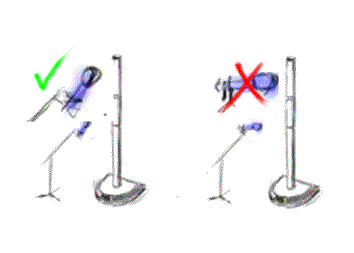Feedback / Microphone
Here are some notes about feedback. Rather than sending you following links, I've just put things that seemed relevant below.
From the Bose Support Site
My vocal microphone keeps encountering feedback. Is there anything I can do to stop it?
- Orient the microphone so that it is not pointing directly at your Cylindrical Radiator™ loudspeaker. It’s best when your system is not directly behind you- give greater than 5 feet distance between you and your system.
- Try using a “close-miking” technique to increase the gain at the microphone and to reduce unwanted stage sound.
- Use the HIGH tone control knob for the microphone channel carefully. Feedback could occur when this is set too high.
- Upgrade your power stand to newer software that offer a high gain preset. see: Software Upgrading (This covers firmware update and Version 2.0 Presets)
- If using a vocal effects processor, make sure that it is not contributing to the feedback problem.
- If stand -mounting a directional microphone, tilt the microphone up ten or twenty degrees off the horizon so that it is less sensitive to direct sound from the speakers.
- Try a different microphone such as a directional mic. Hypercardioid microphones work well with the system.
Here's a sketch of setting up a microphone on stand.
Other general notes
- All players should be playing / singing through the Bose System closest to them
- Every doubling of distance between the microphone and the singer reduces gain-before-feedback by a factor of 4. The difference between 1/2 inch and an inch can be significant.
- Wherever possible "acoustic" instruments should use pickups instead of microphones. This is important because many players find it a struggle to keep a consistant and close distance between the microphone and their instrument. Also, an instrument can be a source of feedback as it resonates with the amplified sound.
- Another (low prority) design guide-line could be to keep open mics as far apart as possible. Neighboring systems with open mics can mututally decrease gain-before-feedback
Handling the Microphone
shure.com notes [1]
Seems like a pretty natural thing, doesn't it? But how your vocalists handle the mic has a major effect on the resulting sound. It may look great, but your tech team won't get the sound they want when your soloist holds a microphone an arm's length from her mouth.
Why?
The first reason is the inverse square law. If you hold your mic a half-inch from your lips it receives a given amount of sound energy from your voice. Move it twice as far-one inch-and it receives one-fourth as much energy. That extra half -inch takes away three-quarters of the efficiency of your sound system. While good mic technique involves "working" the microphone, singers that fully extend their arms when reaching for that climax, are usually doing it for dramatic effect. Small changes in distance from the mouth can result in very dramatic changes in sound level.
Second: When you move the mic away from your lips, you must turn up the microphone level at the mixer to be heard, and more unwanted sound enters the mic. When sound from a monitor speaker enters the mic, it instantly becomes the earsplitting screech we know as feedback. Keeping the mic close to your mouth minimizes feedback.
See the whole article: Miking Live Vocals
ST 15:46, 22 August 2006 (GMT-7)
